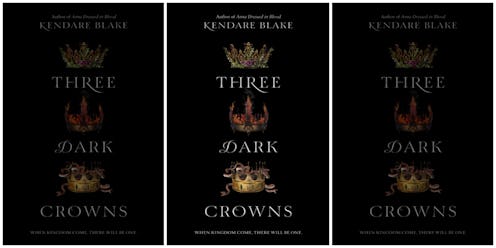Books
Author Kendare Blake Talks Darkness In YA Lit

Young adult fantasy author Kendare Blake is no stranger to writing about darkness. Her series Anna Dressed In Blood is about a murderous teenage ghost; her new series, Three Dark Crowns is about powerful triplets who must fight to the death for the crown.
Not exactly light and fluffy.
“Somehow, everything I write is tinged with darkness,” Kendare Blake tells Bustle. “Even the ones that end with hope. I suppose darkness just fascinates me. I've never really believed in a happy ending.”
It can be hard to believe in a happy ending sometimes, even if you’re not a writer. As someone who deals with depression, I often find myself feeling like I’m trapped in a tunnel. As a teenager who didn’t always have the words for my mental illness, the hopelessness was even worse. Yet somehow, writing and reading stories about darkness seemed to help.
Three Dark Crowns by Kendare Blake, $10, Amazon
I crave a good tear-jerker, a story that doesn’t end with everything tied up neatly but leaves some knots and tangles, loose threads that snag in my heart and force me to remember the story. A book like The Sun is Also a Star, which ends well but not with everything neat and perfect, is one I’ll remember for years — the way it tore at my heart, the sweet, sweet agony of hope not being fully realized.
The Sun Is Also A Star by Nicola Yoon, $11, Amazon
There’s little need to discuss putting darkness in books for adults, but what about books for teenagers, or even younger? As an aspiring YA author, it’s something I think about a lot as I write my novels.
Blake says that there are two ways to write darkness: the realistic way, and then her way, which is “stabbing and magic,” she said.
“Some darkness, realistic darkness, can make a teen feel less alone,” she says, describing the first kind of darkness. “Reading about characters in difficult situations can be a source of fellowship, and even if a teen isn't suffering that particular issue, it can open them up to the experience through empathy.”
For example: The Hate U Give by Angie Thomas, which recently debuted at #1 on the New York Times bestseller list, is a book inspired by the Black Lives Matter movement. In the novel, Starr, a young black girl, witnesses her unarmed childhood friend killed by a policeman. It's heavy, but it doesn't leave the reader feeling empty or hopeless. There's humor, love, family, friendship, music, inside jokes, good food, sibling feuds, kisses, and more.
Yes, there is anger; there is death; there is sorrow. But this isn't a bad thing. Teens can relate to Starr because she's like them in many ways; and though many teens won't be able to relate specifically to her tragedy, this book can help them empathize with black teenagers who do live that reality.
The Hate U Give by Angie Thomas, $10, Amazon
If you feel anger while reading this book, or sadness, grief, frustration — good. It is a kind of darkness that will only make us better as a society.
Then there’s the other way of writing darkness that Blake mentioned, the fantastical kind — the kind found in Game of Thrones or Harry Potter. That kind is important, too.
“Even that, if done well, can highlight aspects of the human condition in a meaningful way,” Blake says.
Her books highlight the human condition in one spectacular way: by depicting female characters who aren’t always “likeable;” rather, the three queens in her series are imperfect and sometimes devious, conniving, scary.
“A girl doesn't need to be pretty, or charming, or smart to be worthy of page time,” Blake says. “I don't need to like a single character in a book for it to be a worthy read.”
When I asked her whether writing female characters that aren’t bound to be universally liked is risky, Blake says that the main result of doing such a thing is creating a complex character — and that’s a good, valuable, thing.
“It's important for young women to be depicted as complicated, valuable members of society,” she says. “They don't necessarily have to be valued by the stories they are in, but seeing valuable female characters who show many different forms of strength, weakness, resilience and flaw reinforces the idea that females are all of those things, that they have all of those things and are still valuable.”
In addition, fantastical darkness provides an escape from the reality of life by reminding us that sometimes, things could be worse.
“Darkness in horror and fantasy novels, is very escapist,” Blake says. “Close the book, go eat mac and cheese, and be really glad you're only having a math test tomorrow.”
Whether it’s for escapism, empathy, or simply understanding that there can be hope no matter what, darkness in literature — especially for young adults — is important because it’s a fact of life: things can be bad. But they can also be good, despite that. It’s why it’s so important to write multifaceted, layered stories; that, and because writing good books is important to get people reading, and reading is important to development.
“If a teen is reading for fun, congratulations parents and teachers, you've already won,” Blake says. “That teen is going to have a far more interesting interior life, with a greater ease in communication, than a classmate who may be struggling with reading.”
So read — and write — your darkness.